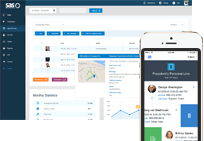- Log In
- Support
- Company
- Contact Us
- Live answers @ 1-888-532-4794
Small Business Pricing to Win, Part 2: Factors that determine pricing

In the first part of this 4-part series, we talked about the various pricing strategies that businesses follow. And if you skimmed it, then you know there are a slew of different pricing models for businesses to sift through. To recap, the top 5 pricing models we discussed were Value-Based Pricing, the Lowest-Price Model, a Cost-Plus Model, the Pay What You Want approach and Dynamic Pricing. With a bunch of different options and with all options making a fairly decent argument for themselves, is it any wonder that pricing mistakes happen?
The reality is, there’s often a lack of understanding of the external (market-based) and internal (organization-based) factors that determine pricing. Lucky for you, we’ve included an overview below.
Internal Factors: There are several organization-based factors that impact pricing. These can be broadly classified as strategy-based and cost-based.
Strategy-Based Factors
Most small businesses do not have a well laid out strategy, so it is essential to spend some time finalizing your Vision (guiding principle) and Mission (the main purpose of being in business). These essential elements are the starting point of your strategy, on which pricing is heavily dependent. Here are 3 key aspects you should know about:
- Business Objective: If your business objective is to gain market share with a new product, then you may want to price lower than the competition to win over prospective customers. If your business objective is to maximize profits with every sale, even if it means selling at a lower volume, then you would set prices higher.
- Target Client Segments: Your target client segments and their capacity to pay are also key determinants of price.
- Product Positioning/Image: A good pricing model requires careful consideration of the image you want to convey to customers. Are you dealing with commodities or premium goods? Premium positioning should be accompanied by premium pricing. Even if you can`t position your product at the highest premium, you need to differentiate your offering from that of your competitors.
Cost-Based Factors
While it is ambitious to aim for premium pricing for your products, small businesses often struggle to convince clients to pay more for their services. A good starting point for pricing is to take cost-based factors into consideration and start off with a cost-plus margin model. Once your business is established, you can bring out value-added versions at premium prices. Here is a list of costs that should be considered while arriving at your price:
- Production Cost: It is critical to know what it costs for you to manufacture/source your product. You should also be able to work out which of these costs are fixed and which are variable. For example, if a high proportion of your costs are fixed, then you may not have much flexibility to reduce prices and boost sales. On the other hand, if your production cost falls significantly with volume, then pricing lower will allow you to increase sales while still generating profit.
- Channels of Distribution Costs: Over and above production costs, you will have distribution channel costs. For example, if you have a physical store as well as a website through which you sell your products, then the costs involved in both cases would be different, and this would need to be factored into the pricing decision.
- Sales & Marketing Costs: Sales and marketing costs also affect pricing. These expenditures vary depending on the geography, channel and customer base that you are handling. It may be more cost-effective to sell to an existing customer than to a new one. That is why most savvy businesses offer discounts to loyal customers. They are essentially passing on the savings in sales and marketing costs to the buyer.
External Factors: Two key external factors that influence pricing are competition and the business’s operating geography.
Competition
What is the competition up to? It’s important to look into how your competitors are doing business, as this will most certainly influence your pricing strategy. You’ll want to do market research to identify the competition and what they are charging. You can even put on your best cloak and dagger routine and mystery shop! Go to their stores, visit their websites, and gather vital intel into their sales processes. The more you know about what competitors are showcasing, the better you can fine-tune how to differentiate your offering, and price your products and services to sell.
Geography
The area that you are operating in will also influence how you price. Labor and related costs, customer affluence, and the presence of competition vary with geography. So, get a handle on your area’s demographics, and figure out how your pricing strategy will reflect those nuances.
Small business owners don’t always realize how significantly pricing strategy affects cash flow. Nevertheless, it is important to appreciate the price-volume trade off and its subsequent impact on business financials. Businesses need to integrate their pricing approach into their financial model, and do sufficient analysis to gauge the consequences of any pricing decision before implementing it.
In our next post, we’ll break down how to arrive at the right price for your product or service through an easy 7-step process.
Categories
- Advice (32)
- Answering Service 101 (18)
- Best Practices (10)
- Call Center Jobs (6)
- Call Center Software (20)
- Comparison (2)
- Customer Service (30)
- Funny (31)
- Holidays (19)
- Industry Hacks (19)
- Infographics (53)
- International (1)
- Medical (8)
- News (12)
- Phone Etiquette (2)
- Phones (14)
- Pricing (8)
- Quizzes (3)
- Receptionist (11)
- SAS Products (29)
- Scripting (4)
- Services (5)
- Small Business (25)
- Starting Up (7)
- Tips and Tricks (19)
- Uncategorized (1)
- Videos (19)
- Workplace (6)
Recently writen
- Call Center Script Best Practices: Advanced Script Block Tips to Optimize Your Answering Service
- January 2025 Release Notes – Adjustments to Call Details Timeline, New Scripting Updates, Live Transcription, and more!
- April 2024 Release Notes – Voicemail Greetings, Ability to Access Websites With a Username and Password, and more!
- March 2024 Release Notes – New Add-On, Settings Revamp, and more!
Follow Us
How about a demo?
We'll show you how our web portal works and answer any questions you have about SAS.
Schedule a demo







